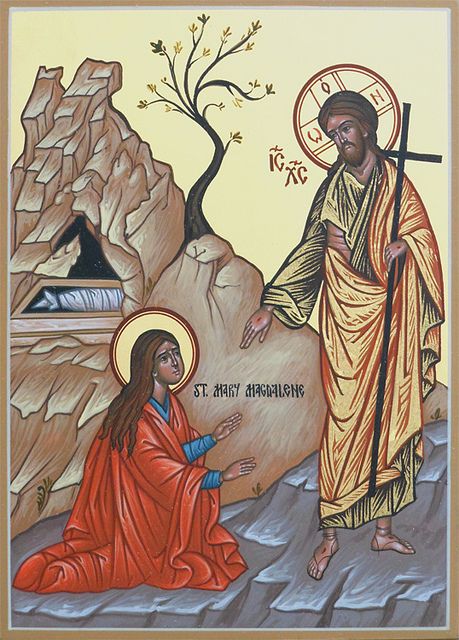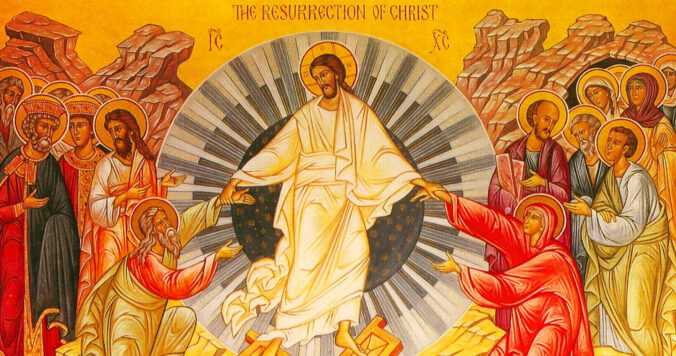
The Harrowing of Hell
Christ is Risen! Truly He is Risen!
Dear Folks,
We are living in troubled times. This year, just before the start of Great Lent, one Orthodox country (Russia) felt compelled to invade another Orthodox country (Ukraine). It is ironic and tragic that Moscow would take military action against Kiev, the original home of Slavic Orthodoxy. Kallistos Ware’s The Orthodox Church (pp. 78-82) describes how Orthodoxy took root in Kiev centuries before Moscow became a Christian city. This delay reflects the gradual spread of the Good News of Christ from Constantinople upwards into the Slavic lands. While Russia and Ukraine have much in common, they are also distinct from each other. This can be seen in the similarity and differences between the two leaders’ names: Vladimir Putin and Volodymyr Zelensky. The situation between Russia and Ukraine is complicated and confusing. Orthodox Christians in the U.S. should avoid rushing to pass judgment. I suggest that they also take into consideration Samuel Huntington’s Clash of Civilization thesis.
This is not the first time Orthodoxy has experienced times of darkness and confusion. In 1204, Catholic Crusaders attacked the fellow-Christian city of Constantinople leading to five decades of Orthodox Christians living under papal rule. In 1453, Constantinople fell to the Muslim Turks leading to centuries of Orthodoxy under Muslim rule. The 1917 Russian Revolution led to a generation of Orthodox Christians in Russia and Eastern Europe living under an atheistic state determined to eradicate Orthodoxy. Orthodox Christians endured these challenging and confusing circumstances holding fast to their faith in the Crucified Savior who would rise on the Third Day. The resurrection icon teaches us that the Incarnate Son of God entered into the realm of Death, destroyed the power of Death and set free those languishing in Hell/Hades. “Since therefore the children share in flesh and blood, he himself likewise partook of the same nature, that through death he might destroy him who has the power of death, that is, the devil, and deliver all those who through fear of death were subject to lifelong bondage.” (Hebrews 2:14-15; RSV)

Mary Magdalene Encountering the Risen Christ
The times we are in currently find parallels in the times of Christ. Religious leaders colluded with secular rulers, the innocent suffered, and the righteous were put to death for speaking the truth. Matthew chapter 2 tells of King Herod plotting to kill the Christ Child and slaughtering the Holy Innocents. Luke chapter 3 recounts John the Baptist being imprisoned by King Herod for speaking out against the tetrarch’s immoral lifestyle. We learn from Mark chapters 14 and 15 how the disciples responded to the atrocities inflicted on Christ by the religious hierarchy and the secular authorities. Many of Jesus’ followers buckled under pressure, running away and denying they knew Jesus. Only a few remained faithful during those dark hours, the unnamed young man who followed Christ wearing only his night clothes (Mark 14:51-52), and the secret followers: Nicodemus and Joseph of Arimathea. It was the Theotokos and the Beloved Disciple, and a group of women who remained faithful up to Jesus’ last moments on the Cross (John 19:25-27). In the hour of darkness and confusion, it was the little folks who remained faithful to Christ, while the big men broke and ran. It is fitting then that on Easter morning Jesus would first show himself to the least of the disciples. In Peter’s restoration we learn that it is possible for unfaithful Christian leaders can be restored to ministry, but they must first show sincere remorse for their apostasy and moral compromise. So, when we find ourselves in circumstances of darkness and confusion, let us remember how God honored the little folks who remained faithful and showed kindness and mercy to the VIP leaders as well. Here we see the mystery of the kingdom of God.
Christ is Risen! Truly He is Risen!
Robert Arakaki
P.S. – Readers should be aware that there is a copycat site: Orthodoxbridge dot blogspot dot com. I have nothing to do with it, and I have had no contact with it. The site administrator just copied my blog’s name and used it for his own site. The blogspot site does not support Orthodoxy.


Recent Comments